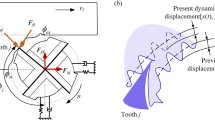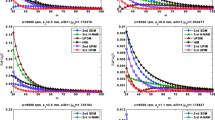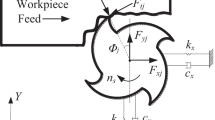Abstract
Different pitch parameters of the tool can lead to the changes in the delay of the machining system. A mechanical model of the variable pitch tool is developed by taking the regenerative chatter into account in the machining system with multiple delays. The dynamic differential equations with multiple delays are studied based on the fully discrete method; the Gaussian integral method is used to approximate the state item of the vibration response in the discrete interval, and the periodic and the delay items are linearly approximated to determine the transition matrix of the discrete state in the multiple delays period. The relationship between cutting force coefficients and cutting parameters is defined based on the size effect of the tool-workpiece contact area; a nonlinear model of the cutting force coefficients is presented by the cutting force detection experiment of aluminum alloy milling with the variable pitch tool. The state transition matrix of the multiple delays system is obtained by combining the Gauss full discrete method with the nonlinear cutting force coefficients, and then the effectiveness of the proposed method is verified by analyzing the convergence degree of the eigenvalue of state transition matrix. At the same time, the relationship between cutting parameters and the stability critical of the machining system is analyzed to draw the three-dimensional stability lobe diagram, which makes it clear that the limiting cutting depth of the tool increases about 2–3 times as the cutting width decreases. Combining with a cutting stability experiment of the variable pitch tool, it is verified that the dynamic model with the nonlinear dynamic parameters has higher prediction accuracy of the cutting stability than others. And it is observed that the eigenvalue of changes of the dynamic model is more violently in the low speed region (2000–4000 rpm), which indicates that the stability of the processing system is more sensitive to the cutting depth under the low speed condition, and the vibration reduction performance of variable pitch tools is more significant.










Similar content being viewed by others
Data availability
All data generated or analyzed during this study are included in this article.
References
Slavicek J (1965) The effect of irregular tooth pitch on stability of milling. Proceedings of the Sixth MTDR Conference. London, UK: Pergamon Press, pp 15–22
Opitz H, Dregger E, Rose H (1966) Improvement of the dynamics stability of the milling process by irregular tooth pitch. Adv Mach Tool Des Res Proc MTDR Conf 7:213–227
Olgac N, Sipahi R (2007) Dynamics and stability of variable-pitch milling. J Vib Control 13(7):1031–1043
Turner S, Merdol D, Altintas Y, Ridgway K (2007) Modelling of the stability of variable helix end mills. Int J Mach Tools Manuf 47(9):1410–1416
Sims N, Mann B, Huyanan S (2008) Analytical prediction of chatter stability for variable pitch and variable helix milling tools. J Sound Vib 317:664–686
Jin G, Zhang Q, Qi H, Yan B (2014) A frequency-domain solution for efficient stability prediction of variable helix cutters milling. Proc Inst Mech Eng C J Mech Eng Sci 228(15):2702–2710
Altintas Y, Budak E (1999) Analytical prediction of stability lobes in milling. CIRP Ann 44(1):357–362
Altintas Y, Engin S, Budak E (1999) Analytical stability prediction and design of variable pitch cutters. J Manuf Sci Eng-Trans ASME 121:173–178
Budak E (2003) An analytical design method for milling cutters with nonconstant pitch to increase stability, part I: theory. J Manuf Sci Eng 125(1):29–34
Otto A, Rauh S, Ihlenfeldt S, Radons G (2017) Stability of milling with non-uniform pitch and variable helix tools. Int J Adv Manuf Technol 89:2613–2625
Bari P, Kilic ZM, Law M, Wahi P (2021) Rapid stability analysis of serrated end mills using graphical-frequency domain methods. Int J Mach Tools Manuf 171:103805
Insperger T, Stépán G (2002) Semi discretization method for delayed system. Int J Numer Meth Eng 55:503–518
Insperger T, Stépán G (2004) Updated semi-discretization method for periodic delay-differential equations with discrete delay. Int J Numer Meth Eng 61(1):117–141
Insperger T, Stépán G, Turi J (2008) On the higher-order semi-discretizations for periodic delayed systems. J Sound Vib 313(1–2):334–341
Sellmeier K, Denkena B (2011) Stable Islands in the stability chart of milling processes due to unequal tooth pitch. Int J Mach Tools Manuf 51:152–164
Sims N, Mann B, Huyanan S (2008) Analytical prediction of chatter stability for variable pitch and variable helix milling tools. J Sound Vib 317(3–5):664–686
Comak A, Budak E (2017) Modeling dynamics and stability of variable pitch and helix milling tools for development of a design method to maximize chatter stability. Precis Eng 47:459–468
Guo M, Zhu L, Yan B, Guan Z (2021) Research on the milling stability of thin-walled parts based on the semi-discretization method of improved Runge-Kutta method. Int J Adv Manuf Technol 115(7):2325–2342
Ding Y, Zhu L, Zhang X, Ding H (2010) A full-discretization method for prediction of milling stability. Int J Mach Tools Manuf 50(5):502–509
Ding Y, Zhu L, Zhang X (2010) Second-order full-discretization method for milling stability prediction. Int J Mach Tools Manuf 50(10):926–932
Insperger T (2010) Full-discretization and semi-discretization for milling stability prediction: some comments. Int J Mach Tools Manuf 50(7):658–662
Zhang XJ, Xiong CH, Ding Y (2010) Improved full-discretization method for milling chatter stability prediction with multiple delays. Intelligent Robotics and Applications: third International Conference, ICIRA 2010, Shanghai, China, Proceedings, Part II 3. Springer Berlin Heidelberg, pp 541–552
Quo Q, Jiang Y (2012) On the accurate calculation milling stability limits using third-order full-discretization method. Int J Mach Tools Manuf 62:61–66
Ozoegwu C (2014) Least squares approximated stability boundaries of milling process. Int J Mach Tools Manuf 79:24–30
Ozoegwu C, Omenyi S, Ofochebe S (2015) Hyper-third order full-discretization methods in milling stability prediction. Int J Mach Tools Manuf 92:1–9
Niu J, Ding Y, Zhu L, Ofochebe S (2014) A generalized Runge-Kutta method for stability prediction of milling operations with variable pitch tools. Int Mech Eng Congr Expo 2:1–8
Niu J, Ding Y, Zhu L (2017) Mechanics and multi-regenerative stability of variable pitch and variable helix milling tools considering runout. Int J Mach Tools Manuf 123:129–145
Yan Z, Zhang C, Jiang X, Ma B (2020) Chatter stability analysis for milling with single-delay and multi-delay using combined high-order full-discretization method. Int J Adv Manuf Technol 111(5–6):1401–1413
Totis G, Sortino M (2020) Polynomial Chaos-Kriging approaches for an efficient probabilistic chatter prediction in milling. Int J Mach Tools Manuf 157:103610
Wei X, Miao E, Ye H (2022) Analytical prediction of three dimensional chatter stability considering multiple parameters in milling. Int J Precis Eng Manuf 23(7):711–720
Liu F, Zhao Y (2022) A hybrid method for analysing stationary random vibration of structures with uncertain parameters. Mech Syst Signal Process 164:108259
Srivastava HM, Iqbal J, Arif M, Khan A, Gasimov YS, Chinram R (2021) A new application of Gauss quadrature method for solving systems of nonlinear equations. Symmetry 13(3):432
Liu Q, Zhang J, Yan L (2010) A numerical method of calculating first and second derivatives of dynamic response based on Gauss precise time step integration method. Eur J Mech-A/Solids 29(3):370–377
Ozturk B, Lazoglu I (2006) Machining of free-form surfaces. Part I: analytical chip load. Int J Mach Tools Manuf 46(7–8):728–735
Ozturk B, Lazoglu I, Erdim H (2006) Machining of free-form surfaces. Part II: calibration and forces. Int J Mach Tools Manuf 46(7–8):736–746
Ozturk E, Tunc L, Budak E (2009) Investigation of lead and tilt angle effects in 5-axis ball-end milling processes. Int J Mach Tools Manuf 49(14):1053–1062
Ozturk E, Ozkirimli O, Gibbons T, Saibi M, Turner S (2016) Prediction of effect of helix angle on cutting force coefficients for design of new tools. CIRP Ann 65:125–128
Larue A, Altintas Y (2005) Simulation of flank milling processes. Int J Mach Tools Manuf 45(4–5):549–559
Wang G, Peng D, Qin X, Cui Y (2012) An improved dynamic milling force coefficients identification method considering edge force. J Mech Sci Technol 26:1585–1590
Campatelli G, Scippa A (2012) Prediction of milling cutting force coefficients for aluminum 6082–T4. Procedia CIRP 1:563–568
Yao Z, Liang X, Luo L, Hu J (2013) A chatter free calibration method for determining cutter runout and cutting force coefficients in ball-end milling. J Mater Process Technol 213:1575–1587
Grossi N, Sallese L, Scippa A, Campatelli G (2015) Speed-varying cutting force coefficient identification in milling. Precis Eng 42:321–334
Yu G, Wang L, Wu J (2018) Prediction of chatter considering the effect of axial cutting depth on cutting force coefficients in end milling. Int J Adv Manuf Technol 96:3345–3354
Funding
This work was supported in part by the Central Government for Supporting the Local High Level Talent (number 2020GSP11).
Author information
Authors and Affiliations
Contributions
All authors participate in the analysis and discuss the results and contributed to the final manuscript.
Corresponding author
Ethics declarations
Conflict of interest
The authors declare no competing interests.
Additional information
Publisher's Note
Springer Nature remains neutral with regard to jurisdictional claims in published maps and institutional affiliations.
Rights and permissions
Springer Nature or its licensor (e.g. a society or other partner) holds exclusive rights to this article under a publishing agreement with the author(s) or other rightsholder(s); author self-archiving of the accepted manuscript version of this article is solely governed by the terms of such publishing agreement and applicable law.
About this article
Cite this article
Nie, W., He, C. & Zheng, M. Stability for multiple delays machining system with variable pitch tools considering nonlinear cutting force coefficients. Int J Adv Manuf Technol 130, 3905–3916 (2024). https://doi.org/10.1007/s00170-024-12977-2
Received:
Accepted:
Published:
Issue Date:
DOI: https://doi.org/10.1007/s00170-024-12977-2




